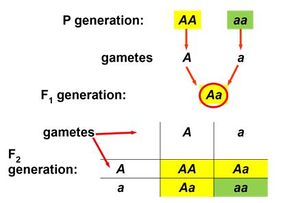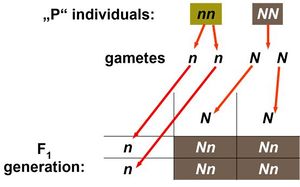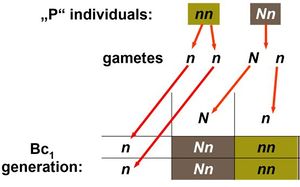Autosomal recessive inheritance in pedigree and experiment, examples of traits in man
Characteristics of AR pedigrees[edit | edit source]
- the trait is often found in clusters of siblings but not in their parents and offspring
- males and females are equally likely to be affected (in a population, the proportion of affected males should be equal to the proportion of affected females)
- parents could be relatives (the couple related by blood, such as first cousins)
Examples of pedigrees[edit | edit source]
AR disease/trait examples[edit | edit source]
- cystic fibrosis (mucoviscidosis),
- phenylketonuria,
- sickle cell anemia,
- albinism.
Important about AR inheritance in pedigree[edit | edit source]
All individuals with the defect/disease in pedigrees (and in population) are homozygotes of recessive defective (deleterious, nonactive, affected, mutated etc.) alleles, aa. Two copies of a disease allele are needed for an individual to express the phenotype. The parents of an affected (suffering with an AR disease) individual are healthy (not affected by this AR disease) but are disease carriers. Typically, once a child in a family is born with AR trait/disease we may suppose parents as carriers (heterozygotes Aa) and there is a 25% (1/4) chance (probability, risk) that any next offspring will inherit two copies of the disease allele and will therefore have the disease phenotype. N.B.: There is a 50% (1/2) chance that the offspring of carrier parents will inherit one copy of the disease allele and will be a carrier, and there is a 25% probability the offspring will inherit healthy (normal, wild-type etc.) allele from both parents (will be a homozygote AA) and will not express the disease phenotype or be a disease carrier. This AA individual would not pose a risk for passing the disorder on to his/her offspring.
Many AR diseases (disorders) are seen more frequently in individuals of certain ethnic origins than others because these individuals are descendants of the same ancestors. However, because these common ancestors are generally more distantly related to these individuals, couples of the same ethnic background would generally have fewer genes in common than consanguineous couples.
AR inheritance in hybridization experiment[edit | edit source]
In experimental procedure, pure lines (e.g. inbred strains) are chosen showing difference in a character (purple versus white flowers, yellow versus green seeds/pies, colour versus albino coat/fur). Parental generation pairs are formed combining one individual from each line/strain. They are crossed in order to obtain F1 hybrids, these are phenotypically uniform, all expressing a single form of the trait (character). By intercrossing the F1 individuals, the F2 generation is obtained, where phenotypes segregate in ratio 3: 1 (one vs. the other form of the trait). This 1/4 correspond to recessive phenotype (not seen in the uniform F1 generation) and, retrospectively, also allow to decide which line (strain) in P generation expressed the recessive form of the trait.
In a general population with uniform (wild) phenotype, an individual with an exceptional (newly appearing) form of the phenotype can be tested by hybridization experiment, too, if he/she/it expresses the dominant or recessive form of the trait.
If this new, different form of a trait is recessive (i.e. new phenotype individual is a homozygote nn), then this hybridization test (crossing with any individual with normal, common, wild phenotype in the population) represents de facto:
- most probably, a parental cross (wild phenotype individual is a homozygote NN) which leads to uniform (F1) hybrids expressing the wild phenotype, or;
- rarely, a backcross (in case that the wild phenotype individual is a hidden, “silent” heterozygote Nn) resulting in phenotypic ratio 1 to 1.
Experimental cross in a population (AR inheritance) – new, spontaneous mutant is recessive homozygote, and wild-type phenotype individuals are (most probably) dominant homozygotes.
Backcross (experimental test-cross) in AR inheritance – rarely, wild-type phenotype individuals are heterozygotes (by the way, they had to be at least two of them, of opposite gender in preceding generation of the population; it is the only way how a recessive homozygote could appear in the present generation of the population).




